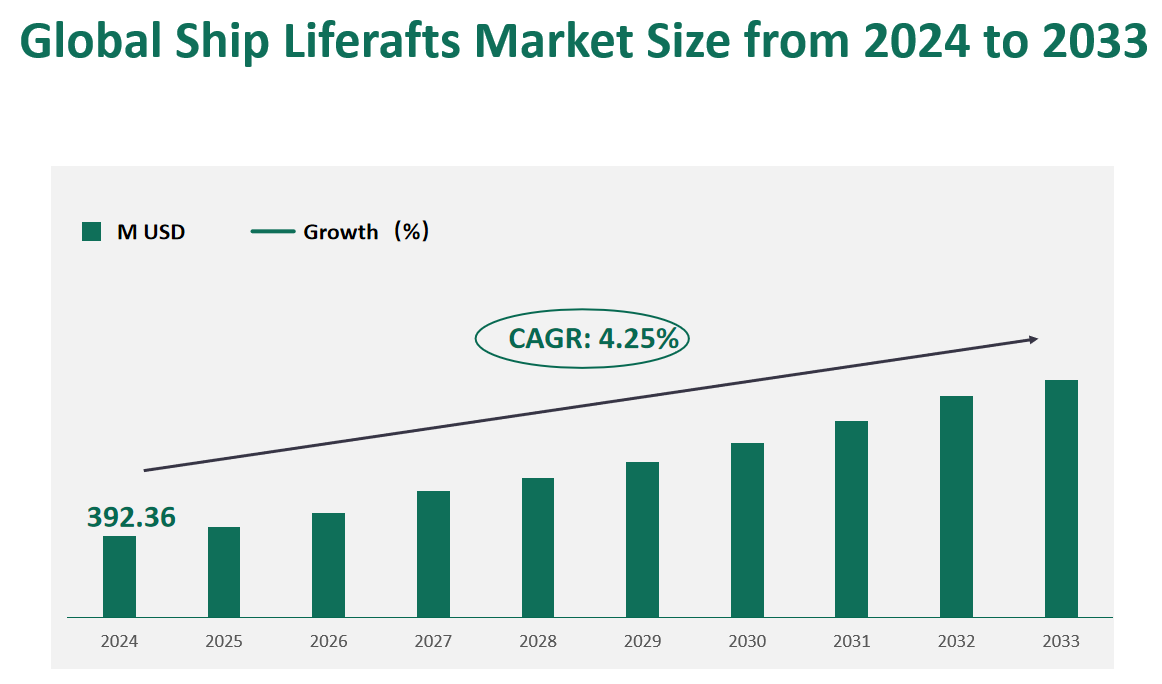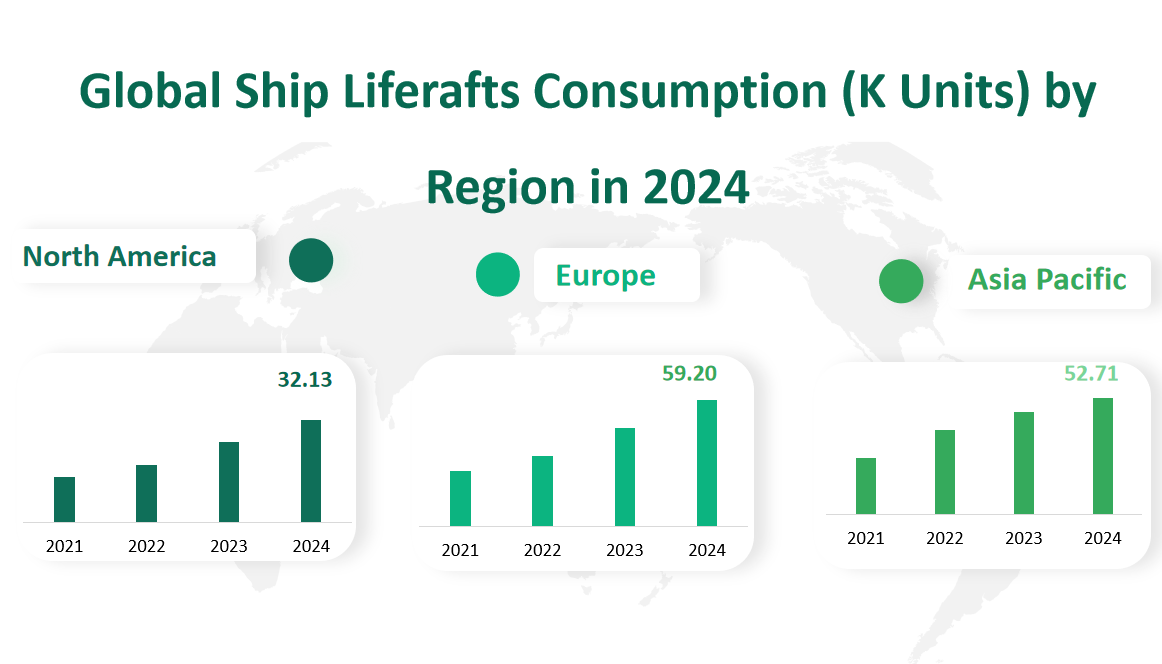1 Global Ship Liferafts Market Insight Analysis
The global Ship Liferafts market will be worth approximately $392.36 million in 2024, with a CAGR of 4.25% from 2024 to 2033.
Ship Liferafts is an inflatable boat carried onboard a ship. It can be used for evacuation in case of an emergency or disaster on the vessel. Ship Liferaftst comes in different sizes and is made of sturdy material like neoprene or polyurethane fabric. It is essential safety equipment.
Figure Global Ship Liferafts Market Size (M USD) and CAGR (2024-2033)

2 Ship Liferafts Market Growth Drivers and Restraints
The ship liferafts market is influenced by a multitude of factors that either stimulate growth or pose constraints on the industry. Among the key drivers is the increasing emphasis on safety regulations in the maritime industry. International maritime organizations and national authorities have stringent rules regarding the safety equipment, including liferafts, that must be carried on board ships. This has created a steady demand for ship liferafts as vessels seek compliance with these regulations.
Another significant driver is the rise in global maritime trade, which has led to an increase in the number of commercial vessels on the seas. The growth of the offshore industry, including oil and gas platforms, has also contributed to the demand for liferafts, as these platforms require safety equipment for their crew. Additionally, the trend towards larger passenger vessels for leisure and tourism has increased the need for liferafts capable of accommodating more people.
The market is also driven by technological advancements that enhance the performance and reliability of liferafts. Innovations such as self-righting mechanisms, improved materials for buoyancy, and easier deployment systems have made liferafts more effective and user-friendly, thus increasing their adoption.
However, the market faces constraints that could hinder growth. One of the main challenges is the fluctuation in raw material prices, particularly for materials like neoprene and polyurethane, which are used in the construction of liferafts. These price fluctuations can impact the profitability of manufacturers and affect the overall cost of liferafts.
Intense competition within the market is another constraint. With numerous manufacturers offering similar products, the market is highly competitive, which can lead to price wars and reduced margins. Additionally, the entry of new players with lower-cost products can disrupt the market dynamics and pose a challenge to established manufacturers.
The COVID-19 pandemic has also introduced uncertainties into the market, with disruptions to global supply chains affecting the production and distribution of liferafts. The pandemic has led to delays in manufacturing and shipping, which has impacted the delivery of liferafts to customers.
3 Technological Innovations and Mergers in the Ship Liferafts Market
Innovation and strategic business moves, such as mergers and acquisitions, play a pivotal role in shaping the ship liferafts market. Technological innovation is at the forefront, with companies investing in research and development to create liferafts that are more reliable, durable, and user-friendly. Innovations in materials have led to the development of liferafts that are lighter, more buoyant, and resistant to harsh marine environments. Advances in deployment mechanisms have made it easier and quicker to deploy liferafts in emergency situations, potentially saving more lives at sea.
Mergers and acquisitions have been significant in consolidating the market and expanding the reach of key players. For instance, Survitec’s acquisition of Blue Anchor Fire & Safety has strengthened its position in the survival solutions market, particularly in the fisheries, maritime, and offshore energy sectors. This move has allowed Survitec to broaden its product range and enhance its service capabilities.
Similarly, VIKING’s acquisition of Norsafe, a leading lifeboat manufacturer, has expanded VIKING’s product portfolio and reinforced its commitment to meeting customer needs in the maritime safety industry. These acquisitions not only expand the product offerings and market presence of the acquiring companies but also contribute to technological synergies and operational efficiencies.
In summary, the ship liferafts market is driven by the necessity for enhanced safety measures at sea, the growth of global maritime trade, and technological advancements. However, it is constrained by raw material price volatility, intense competition, and the impact of the COVID-19 pandemic on supply chains. Innovations and strategic business acquisitions are key in navigating these challenges and positioning companies for success in this critical safety equipment market.
4 Global Ship Liferafts Market Size by Type
Throw Over Liferafts: This type is projected to generate approximately $165.71 million USD in revenue, accounting for about 42.23% of the total market share. Throw Over Liferafts are designed to be easily deployed by throwing them overboard, where they inflate automatically upon contact with water. Their ease of use and quick deployment make them a popular choice for various vessels, particularly in emergency situations where time is of the essence.
Davit Launch Liferafts: The Davit Launch Liferafts segment is expected to achieve a revenue of around $107.79 million USD, representing 27.47% of the market share. These liferafts are launched from a davit system, allowing for controlled deployment from the ship’s deck. This type is commonly used on larger vessels, where the davit system ensures a safe and efficient launch, making it suitable for commercial shipping and offshore applications.
Self Righting Liferafts: This segment is forecasted to contribute approximately $74.53 million USD in revenue, capturing 18.99% of the market share. Self Righting Liferafts are designed to automatically orient themselves upright upon inflation, ensuring that they are ready for boarding regardless of how they land in the water. This feature is particularly advantageous in turbulent sea conditions, providing an added layer of safety for users.
Open Reversible Liferafts: The Open Reversible Liferafts segment is projected to generate around $44.33 million USD, accounting for 11.30% of the market share. These liferafts are versatile and can be used in various emergency scenarios. They are designed to be deployed quickly and can accommodate multiple passengers, making them suitable for both commercial and leisure vessels.
Table Global Ship Liferafts Market Size and Share by Type in 2024
|
Type |
Market Size (M USD) 2024 |
Market Share 2024 |
|---|---|---|
|
Throw Over Liferafts |
165.71 |
42.23% |
|
Davit Launch Liferafts |
107.79 |
27.47% |
|
Self Righting Liferafts |
74.53 |
18.99% |
|
Open Reversible Liferafts |
44.33 |
11.30% |
5 Global Ship Liferafts Market Size by Application
The commercial application is projected to dominate the market, with an estimated consumption volume of 136.40 K Units, which accounts for approximately 85.77% of the total market consumption. This segment includes liferafts utilized on various commercial vessels such as cargo ships, oil tankers, and passenger ferries. The high demand in this sector is driven by stringent safety regulations that require commercial vessels to be equipped with adequate liferaft capacity to ensure the safety of all passengers and crew members. The increasing number of commercial vessels and the expansion of global trade further bolster the demand for reliable liferaft solutions in this application.
The leisure application is expected to contribute around 22.64 K Units, representing approximately 14.23% of the market share. This segment encompasses liferafts used on recreational boats, yachts, and other leisure vessels. The growth in this sector is fueled by the rising popularity of recreational boating activities and the increasing awareness of safety measures among boat owners. As more individuals engage in leisure activities on the water, the demand for safety equipment, including liferafts, is anticipated to rise.
Table Global Ship Liferafts Market Size and Share by Application in 2024
|
Application |
Consumption (K Units) 2024 |
Market Share 2024 |
|---|---|---|
|
Commercial Use |
136.40 |
85.77% |
|
Leisure Use |
22.64 |
14.23% |
6 Global Ship Liferafts Market Size by Region
The North American market is projected to consume approximately 32.13 K Units, accounting for about 20.20% of the total market consumption. The United States is the primary contributor to this volume, driven by a robust maritime industry and stringent safety regulations. The region’s focus on enhancing maritime safety standards and the presence of major shipping companies further support market growth.
Europe is expected to lead the market with a consumption volume of around 59.20 K Units, representing 37.22% of the market share. The European maritime industry is well-established, with a strong emphasis on safety regulations and advanced liferaft technology. Countries like Germany, the UK, and France are significant contributors to this market, reflecting the region’s commitment to maritime safety.
The Asia Pacific region is projected to consume approximately 52.71 K Units, capturing 33.14% of the market share. This growth is primarily driven by the increasing number of commercial vessels and the expansion of the offshore industry in countries like China and Japan. The region’s rapid industrialization and growing demand for maritime safety solutions are key factors influencing market dynamics.
The Latin American market is expected to contribute around 7.82 Units, accounting for 4.92% of the total market consumption. The growth in this region is supported by the increasing number of fishing vessels and the need for safety equipment in maritime operations.
Middle East and Africa region is projected to consume approximately 7.18 K Units, representing 4.51% of the market share. The growth in the Middle East and Africa is driven by the expansion of the oil and gas industry, which requires robust safety measures for offshore operations.
Figure Global Ship Liferafts Consumption (K Units) by Region in 2024

7 Global Ship Liferafts Market Analysis by Major Players
7.1 Survitec
Company Introduction and Business Overview:
Survitec, established in 1854, is a global leader in survival technology, catering to the maritime, defense, government, aerospace, and energy sectors. The company is headquartered in the UK and operates worldwide, providing a comprehensive range of safety solutions.
Survitec is recognized as the world’s largest manufacturer and supplier of liferafts, marine evacuation systems (MES), and offshore rental personal protective equipment (PPE). The company emphasizes innovation and quality, ensuring that its products meet the highest safety standards required by international maritime regulations.
Products:
Survitec’s product offerings include a variety of liferafts such as self-righting liferafts, throw-over liferafts, and davit-launched liferafts. Their liferafts are designed for various vessel types, ensuring safety and compliance with SOLAS (Safety of Life at Sea) regulations. Additionally, Survitec provides a range of marine safety equipment, including life jackets, immersion suits, and fire solutions.
7.2 VIKING
Company Introduction and Business Overview:
Founded in 1960, VIKING Life-Saving Equipment A/S is a Danish company that has grown to become a global market leader in maritime and offshore safety. The company operates manufacturing facilities in Denmark, Norway, Bulgaria, and Thailand, serving customers worldwide.
VIKING specializes in providing and servicing safety and firefighting equipment for various maritime applications, including passenger and cargo ships, offshore installations, and fishing vessels. The company is committed to enhancing safety standards and ensuring that its products are reliable and effective in emergency situations.
Products:
VIKING’s product range includes liferafts, lifeboats, life jackets, immersion suits, and marine evacuation systems. Their davit-launched liferafts and self-righting liferafts are particularly popular among commercial shipping operators due to their ease of use and compliance with stringent safety regulations.
7.3 FUJIKURA COMPOSITES
Company Introduction and Business Overview:
FUJIKURA COMPOSITES, established in 1901, is a Japanese manufacturer specializing in various industrial rubber products, including inflatable liferafts. The company has a strong presence in the Asia Pacific region and serves markets across Europe and North America.
Originally known for its rubber products, FUJIKURA COMPOSITES has expanded its offerings to include advanced liferaft solutions that meet international safety standards. The company focuses on innovation and quality, utilizing sophisticated manufacturing techniques to produce reliable safety equipment.
Products:
FUJIKURA COMPOSITES offers a range of inflatable liferafts designed for commercial vessels, ensuring compliance with SOLAS regulations. Their liferafts feature rapid inflation systems, durable materials, and user-friendly designs, making them suitable for various maritime applications.

